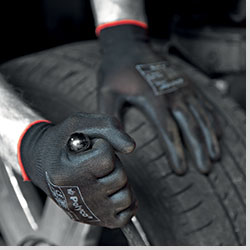PU, or polyurethane, coated gloves are a form of PPE glove that is designed for work that requires precision, and therefore dexterity and sensitivity. They’re made with polyurethane foam and a nylon liner, creating a supple and lightweight barrier for your hands that will protect from workplace hazards such as chemicals and abrasion.
A Guide To PU Coated Gloves

What is polyurethane?
Polyurethane is a widely used form of plastic polymer with a range of utilities, from use as an adhesive to a popular material in gloves and other apparel. Polyurethane can be made in different forms by adding ingredients such as catalysts, blowing agents, and flame retardants to the chemical formulation.
What are the benefits of PU coated gloves?
There are a number of benefits which make polyurethane coated gloves perfectly suited to a range of industries and tasks. These include:
- - Flexibility – Polyurethane is incredibly stretchy, and this makes PU gloves one of the most suitable forms of hand protection for jobs where sensitivity and dexterity is required. The material also continues to offer protection to the wearer when stretched, something that most other flexible materials cannot do effectively.
- - Grip – Another great benefit of PU coated gloves is the unrivalled level of grip which they offer. The properties of the material mean that wearers have increased grip while retaining protection and flexibility.
- - Affordability – Finally, these gloves are also relatively cheap to produce and purchase. This is a great benefit for both companies and tradesmen, as PU gloves typically need replacing often, but the low price means this is not so much of an issue.
What are PU coated gloves used for?
Taking into consideration the benefits listed above, polyurethane gloves lend themselves much more favourably to certain industries and jobs. For example, PU coated gloves are often used in cleanrooms and electronics because they are non-shredding, provide great grip, and offer puncture resistance. They are also especially popular amongst electricians as they are cut-resistant but are still very flexible for the wearer.
Safety standards for PU coated gloves
At Protec, all our hand protection products conform to the latest legislation requirements in order to keep wearers safe from injury during use. For our range of PU coated gloves, this means that each product is approved to:
- - BS EN 388:2003 – This European Standard specifies the full requirements, testing means, and information which must be supplied with mechanical protection gloves, including polyurethane coated gloves. The testing described in this Standard takes into consideration abrasion resistance and puncture resistance.
- - BS EN 420 – This European Standard defines the general requirements and test methods which must be followed during the design and production of all protective gloves.
Employer Responsibilities
In accordance with the Personal Protective Equipment Regulations (2002), employers are required to supply any necessary protective equipment, such as PU coated gloves, to help workers carry out tasks safely. Employees should also be trained in the use of the PPE supplied, and equipment should be repaired or replaced when necessary. Find our selection of PU coated gloves today, or browse our full range of protective gloves for a variety of purposes, including cut resistant gloves, builders grip gloves and much more.
Comments
Latest Blogs

An updated guide by consumer organization Which? looks at how to protect people’s ears. They focus on two main types of ear protection, earplugs and ear defenders.

A review submitted by the Department of Work and Pensions (DWP) has recommended that the Health and Safety Executive (HSE) should compel employers to improve their behaviour in issues of workplace health and safety.

Drivers are being urged to consider their footwear choices when behind the wheel, particularly during hot summer days when flip-flops are popular.

Leave a comment